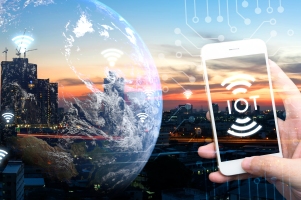From connected cars and wearable devices to smart homes and cities, the Internet of Things (IoT) is transforming the world around us, especially in telecommunications. This fourth industrial revolution — also driven by Artificial Intelligence (AI), robotics, 3D printing, and other emerging technologies — will irrevocably change the way machines interact with humans and each other.
Gartner predicts that over 20 billion connected things will be in use worldwide by 2020, putting service providers in a race to tailor their strategies, data services, and telecom infrastructure to make the most of this trend, says Piyush Tandon, VP & global head of Strategy, Marketing & Business Development, Communications BU at Cyient. What are the greatest opportunities and challenges of IoT in telecommunications? How can industry professionals and companies stay ahead by leveraging IoT? Let’s understand how.
Revenue vs Value
The global telecom industry is seeing its revenues diluted by service commoditisation and competition from over-the-top (OTT) providers. At the same time, data consumption has grown exponentially. IoT in telecommunications will be defined by the ability to deliver high-value, scalable data-driven services that prioritise cost and convenience, while making a positive impact on people’s lives.
The market leaders will be the telecom providers that partner with customers, domain specialists, and platform providers to co-create the next generation of IoT networks.
Data-driven networks
Service quality, reliability, and intelligent dynamic capacity allocation are critically important to IoT services such as autonomous cars, heart-rate monitors, and insulin pumps. Improved network analytics capabilities will allow providers to perform real-time and predictive IoT network maintenance to improve services and keep costs down.

We can expect to see this data-driven approach become a core enabler of intelligent, automated networks that incorporate next-generation technologies like 5G, SDN, NFV, and service cloudification.
Security and privacy
Problems of security and privacy will be particularly challenging in the age of IoT in telecommunications. As there are more devices in a network, there are more points of vulnerability. Additionally, their computational and energy constraints could make higher-level security measures difficult to implement.
The concept of a distributed network, rather than a centralised one with a single point of failure, could greatly benefit IoT security. Additionally, as network intelligence evolves, it’s likely that devices and networks will become knowledgeable enough to be able to proactively identify, locate, and neutralise any harmful threats. The development of uniform regulatory standards for the collection and usage of IoT data will also be important as IoT and Machine-to-Machine (M2M) communications pave the way to the Internet of Everything (IoE).
Telecom infrastructure management
Sharing telecom infrastructure is becoming increasingly popular around the world as changes to regulations lower the barriers to entry and increase competition among providers. Passive infrastructure sharing is a core part of this, given the fact that building and maintaining telecom infrastructure is capital-intensive. The need will only grow as 5G wireless leads to networks that are increasingly decentralised, segmented, and built atop small-cell infrastructure.
IoT will play a key role in not just 5G network services, but also surveillance and monitoring of this next-generation infrastructure. An IoT-enabled Tower Operations Center (TOC) integrates on-site IoT sensors with cloud-based analytics to extract and analyse cell-tower data. This results in increased tower up-time, reduced operational costs, more efficient OSS and BSS, improved site security and intrusion detection, and more efficient energy/power management.
The degree of remote monitoring allows tower and infrastructure companies to monitor alarms and manage key performance indicators via a centralised console. In turn, this allows better overall management of critical passive infrastructure at cell sites, while freeing up IoT telecom professionals to concentrate on better network planning and resourcing.
The final challenge is human: the future IoT market will require teams that can develop processes, platforms, and protocols that make IoT work across a wide range of industries and applications. It’s a problem that telecom service providers are well placed to solve as they look for ways to increase value and transform our world for the better.
The author is Piyush Tandon, VP & global head of Strategy, Marketing & Business Development, Communications BU at Cyient.
Comment on this article below or via Twitter: @VanillaPlus OR @jcvplus






